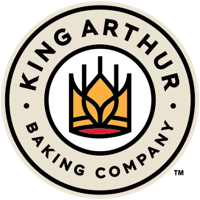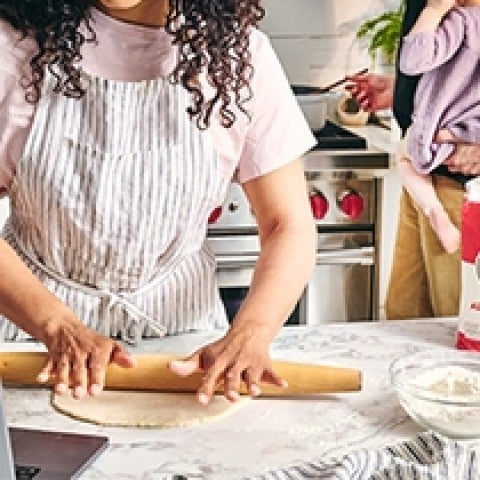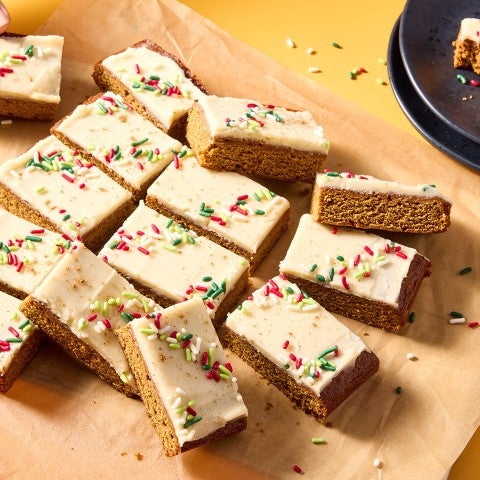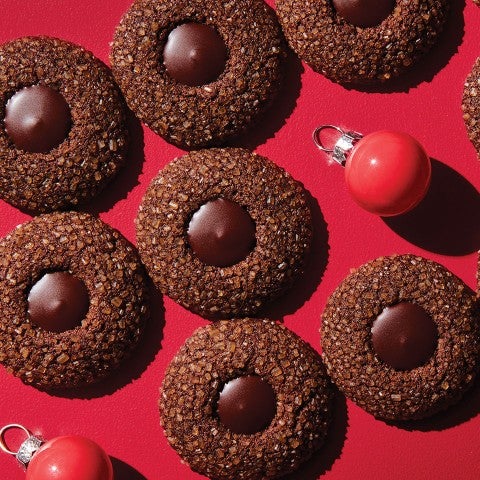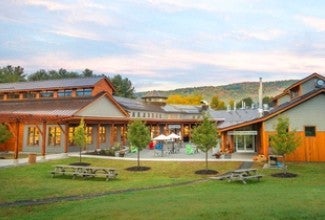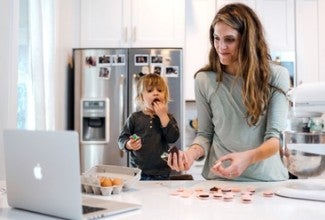The Best of Chinatown Bakeries with Kristina Cho
Listen to this episode below, or wherever you get your podcasts: Spotify | YouTube | Amazon Music | Apple Podcasts
We’re talking about one of our favorite genres of baking today: the bakes of Chinatown.
From bolo bao to dan tat, we can’t get enough of the gorgeous goods lining the bakery cases of Chinatowns across the US. So of course, we had to have cookbook author Kristina Cho on the show to share more about the history of these bakeries, their place in Chinese American communities, and her tips for making the best versions of these iconic bakes at home. Along the way, David and Jessica share their experiences eating in two of the best Chinatowns in the country, plus their answers to your biggest baking questions (with some crucial help from Kristina!). Jessica has a shockingly positive Jess-opinion for once, and she and David close out the show by sharing the recipes they’re baking this week.
Recipes and other links from this episode:
- Find our recipes for Pineapple Buns (Bolo Bao), Hong Kong Egg Tarts, and Red Bean Mooncakes
- Learn more about Kristina’s two cookbooks, Mooncakes & Milk Bread and Chinese Enough
- For more on steamed buns, check out our blog: Everything you need to know to make steamed buns
- Find our Golden Milk Bread recipe in the Big Book of Bread
- And for more on tangzhong and milk bread, see our blog: What is milk bread?
- What David’s baking this week: Bagels (with help from our On-Demand Bagel Class)
- What Jessica’s baking this week: Pumpkin Chocolate Chip Cookies
- Record your question for our Ask the Bakers segment here!
- This episode is sponsored by Plugra. Learn more about their premium European-style butter at plugra.com.
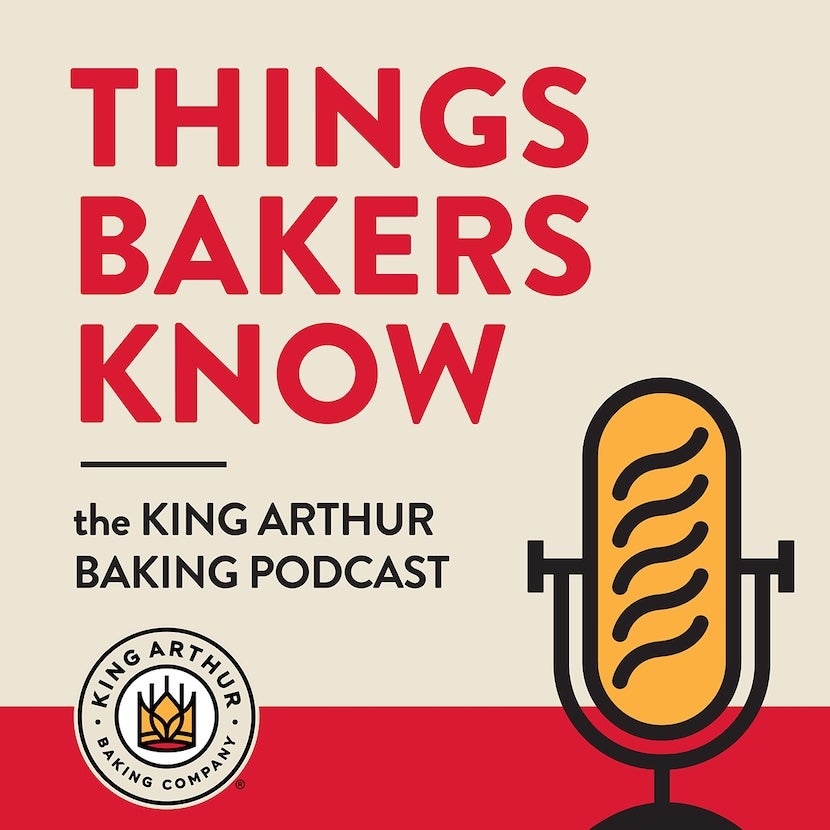
Episode Transcript
Jessica: This season is brought to you by Plugra butter, a premium European-style butter made using a slow churn process. Look for Plugra wherever fine butters are sold.
David: No wrinkles, no coming apart at the seams.
Jessica: Yeah, this is my goal for the next year. I missed the boat on both of those.
David: I could've used this advice a long time ago
From King Arthur Baking Company, this is Things Bakers Know. I'm David Tamarkin, King Arthur's Editorial Director.
Jessica: And I'm Jessica Battilana, Staff Editor at King Arthur Baking. David, I have a funny story to tell you that relates to today's episode.
David: Okay. I hope it's funny, you set it up as funny. I hope it is.
Jessica: Is it funny? Actually, I don't know if it, if funny is the right word.
I have this old car. It's a 1974 Mercedes, four 50 SLC. I can't really explain why I bought this car. Midlife crisis maybe, but I bought this car when I was living in San Francisco. One day I was driving in Hayes Valley and I was turning the corner and all of a sudden I'm rear ended with my children in the backseat.
We're all fine. Because one thing I will say about these old Mercedes is that they're built like tank.
David: This story is not funny so far.
Jessica: Well, I'm getting to the funny, I'm using air quotes, the funny part. So I pull over and again, kids are fine. I'm fine.
But I like look in my rear-view mirror just in time to see this black BMW flee the scene. Basically this guy —
David: Oh really? It was a hidden run.
Jessica: Oh yeah, yeah. He hits us. And then he drives away. And what's notable, most notable about this BMW as I see it speeding away, is that it has a vanity plate.
And the vanity plate reads. D-A-N-T-A-T
David: Dan Tat. Okay.
Jessica: But unfortunately for the driver, I know the phrase Dan Tat, D-A-N-T-A-T, as the name of one of my very favorite things to buy at a Chinatown bakery. So Dan Tat is another name for those egg tarts that you get at Chinatown bakeries that have like a super flaky lard crust, and the really eggy, not too sweet custard in it.
David: Mm-hmm.
Jessica: And this is only relevant because, say, if it had been a sequence of seven numbers as he drove off, there is no way I would've remembered his license plate number.
David: Right. Of course not.
Jessica: But a vanity plate, and particularly a food vanity plate, like of course, lodged immediately in my memory. And so I watched him drive away and I just had this feeling of like calm smugness, because the next thing I did was call my insurance company and they were able to find him and they were able to make him pay for all the repairs to my car.
David: And do you visit him in jail every year, just to like kind of —
Jessica: I bring him egg, egg tarts in prison every year.
David: Well, I think the point is today we're going to be talking about the better Dan Tat, right? Not the vanity plate version. We're talking about the real thing.
Jessica: One nice thing about me and this driver is that we obviously share an enthusiasm for the baked goods that you find in the bakeries of American Chinatowns, and that's the subject — we took the long way around the barn, but that's the subject of today's episode.
David: I'm really excited about this episode because I am such a huge fan of, uh, Chinatown bakeries. And, you know, you and I are lucky to have lived, you know, during the course of our lives in places with really amazing Chinatowns.
That story took place, that horrible story took place in wonderful San Francisco, which has one of the best Chinatowns in America for sure. Right? And I live in New York City where I think that we have a better Chinatown.
Jessica: Oh, wow.
David: I don't know. We'll, we'll, I, this is not the Jess-opinion segment, so I'm not gonna go there.
Jessica: And part of the reason we wanted to talk about the bakeries of Chinatown today is that today is the start of the Mid-Autumn Festival, which is a significant holiday in the Chinese calendar. And it's a time of family reunions, of moon observations, but also a time to eat special foods, including moon cakes, which are a special pastry that you find in Chinatown bakeries, typically only at this time of year.
So we thought we would talk about those and all the other amazing baked goods that you find in a Chinatown bakery today.
David: Today we're gonna be talking to Kristina Cho, author of two cookbooks. But first I'm gonna make you listen to me pontificate about why I love these bakeries so much. You know, the first wave of Chinese immigrants to the United States began in the 1850s when laborers came to work on the transcontinental railroad, and later they came just like a lot of other people for the California gold rush.
And during that time, they established neighborhoods in many American cities, New York, where I live, San Francisco. And they started businesses, including restaurants, and of course bakeries. And the bakeries began by selling steamed buns and other baked goods. But over time, they expanded the repertoire to include western style cakes.
And today, most bakeries in Chinatowns sell a huge array of things. Cakes. Yeah, cookies. Astonishing array buns. All of it.
Jessica: Yeah. I, I think it's worth noting, you know, that neither one of us are Asian. But we have a lot of passion and enthusiasm for these baked goods just because of the sort of breadth and variety and just like the pure deliciousness.
So I'm glad we got Kristina on the episode later to talk to us about the recipes, about her family's history of immigration, and her relationship as an Asian American to these bakeries and these baked goods. It felt like a nice moment to look sort of outside the tradition of European baking because there is such a rich culture of baking, of specific recipes that often don't get as much attention as Western or eastern European style bakes.
David: Although I do feel like that's beginning to change. I feel like so much of the exciting baking in New York, LA, San Francisco, Chicago right now has an East Asian influence. A lot of bakers are really exploring those flavors and doing really exciting things, and there's a real appetite for them, which is why we're doing this episode. 'Cause you and I have an appetite for those things.
Jessica: We sure do. I have a favorite thing that I always get at any Chinatown bakery that I go to, which are the cocktail buns, which is a very sweet, fluffy dough, and then inside of it is this paste made of butter and shredded unsweetened coconut and sugar.
And I just love those. I will always get one of those. I'll always get an egg tart if there is an egg tart, but I always will get a coconut bun. Do you have a favorite?
David: Well, it's not that 'cause I just can't do the coconut thing.
Jessica: Really? You don't like coconut?
David: You talk about coconut on this podcast a lot, and I just do, I've been biting my tongue, but now it's time for me to tell you that I hate coconut.
Jessica: Really?
David: I, I mean, hate is not, I don't hate it, but like, I'm never gonna choose it. So when I'm in a, when I'm in a Chinatown bakery, if I'm choosing a bun, I'm probably going for the pineapple bun, which, okay, for those who don't know, has a craquelin top on it, which is the signature, because that's what makes it look like a pineapple.
Sometimes it has, you know, pastry cream or a different type of filling in it, but what's crucial is that it has that top.
Jessica: Because it doesn't actually have any pineapple fruit in it.
David: No pineapple. And a pineapple bun, it's just, it's just aesthetics that gives it the name.
And you know, sometimes I'll get the roast pork bun, even though I pretend to be vegetarian.
Jessica: That’s my kids' favorite.
David: Yeah. But I actually knew you were gonna ask me this question. So this past weekend I spent a lot of time in New York City's Chinatown and I discovered something about myself, which is, it's not the buns that I love the most.
It's not the chiffon cakes, even though I love all that. It's really the egg tarts, you know? And it's, you know, and at most Chinatown bakeries, you have to make a choice between the Hong Kong style egg tart, which is a short crust or a sort of puff crust. It's a different type of puff pastry than European puff pastry, but with a very smooth, very beautiful sunny yellow egg filling.
And then the Macau or Portuguese style, which is more burnished, has a darker bake, and they have a different set to the custard too.
Jessica: And that is such an interesting, like we could spend a whole episode just, this could be an egg tart episode. Honestly, it would be you, me, and that BMW driver just, you know, breaking it down.
But I think it's really interesting to think about those two styles because I think they represent what has happened, which is of course, like colonization has changed every place in the world. But in particular, you see the Portuguese influence on these egg tarts.
David: Yeah. Chinese puff pastry, traditional Chinese puff pastry is so interesting to me because instead of using butter, they use lard. And instead of using a butter block or a lard block, just a solid block of fat, like French puff pastry does. It's a, it's a really fatty dough, laminated with a leaner dough. Which honestly, sounds, I haven't tried it, but it sounds like it sounds easier and better to me, and the result is wonderful. I mean, it's such a flaky tart with a lot of great structure, beautiful browning sometimes if you're doing the Macau style.
Jessica: And you know, we have a recipe by Genevieve Yam for a Hong Kong style egg tarts on the website.
The head note of that recipe acknowledges the typical dough process, but we sort of streamlined it for home bakers and we use a rough puff that has butter and heavy cream, so it's a little bit easier to deal with at home. And you know, when I look at Kristina's book, you know, she has the classic pineapple buns, she has the cocktail buns, she has the egg tarts in there, but she also has like a peanut butter and jelly bun.
She also has like an everything bagel bun that's stuffed with cream cheese. And so I think she is also playing with it. And to me that is almost the very definition of American baking today because you know, you have all these disparate influences, all these various pastry techniques, and then this sort of out of that grow something kind of wholly new and it's really exciting because I think, you know, it's not as though we are like discovering any of these things.
Certainly not, but I think these are flavors and ingredients that are becoming like more mainstream and that you're finding in more places and that is really compelling to me.
David: I like the way you put that.
Jessica: Thank you.
David: I think that's really nice. And you know what? There's a reason why Kristina Cho could do that, and it's because she's from Cleveland.
So shout out to Ohio bakers. I can't wait to hear your conversation with Kristina.
Jessica: Kristina Cho is an award-winning cookbook author, food stylist, and photographer. Her groundbreaking debut cookbook, Mooncakes and Milk Bread won her two James Beard Awards and was described as an instant classic by the New York Times. She's also the author of the recent cookbook, Chinese Enough. Full of homestyle recipes for noodles, dumplings, stir fries, and more.
You know, it's such a treat for me. Well, I'm so glad you could come on the podcast, because I feel like when I was thinking about who had the expertise to talk to us about, you know, the bakeries of Chinatown and specifically the baked goods in those bakeries, it was a really very obvious choice of, of who to call.
So I'm glad that you took our call and that you came on the podcast.
Kristina Cho: Of course. It's a great honor. I love being that person in people's minds, I guess, like who, who loves the bun? Kristina, you know?
Jessica: I mean, and I think that just speaks to the power of your book. And in fact, I was telling our producer, I got a history degree from college and my focus was actually on Chinese history.
So when I reached out to my former advisor as we were working on this episode, just to get some background about, you know, baking in in China. He was like, every person I talked to mentions this woman, Kristina Cho, you should talk to her. I was like, yes. So, um, I knew we were on the right track. I would love to talk for a minute about the like breadth and depth of the baked goods that you find in a typical Chinatown bakery.
'cause it's kind of astonishing the variety and maybe also for people who have never had the opportunity to go into a Chinese bakery. Like it might be nice for our listeners just to hear tactically, how do you navigate a Chinese bakery? Because it's different than a Western bakery.
Kristina Cho: Absolutely. I'll, I'll paint the picture of a typical typology of a bakery, and I do wanna preface this, that the Chinese bakeries that I think we're talking about and that I write about in the book, really focus on Hong Kong style, Chinese American, a lot of Southern Chinese influence.
When you think about the bread of all Chinese baking, it's huge. Yeah. And this book really only covers like this small subset in a way, but there's still so much in there. Yeah. So when you go to a bakery, you'll probably see some display cakes like in the window. They'll be covered in cream and shiny fruits.
There'll be a bunch of cakes, probably some cheesecakes too, and rolled cakes, which are sponge cakes that have a layer of cream and you roll it up and then there will be sweet and savory buns that are toasty, golden brown, shiny. Everything needs to be shiny. You know, to be appealing. Um, and they're twisted in all these different shapes.
Um, you'll probably find a bolo bao, which is a pineapple bun. It's one of the most iconic buns at a Chinese bakery. There's no pineapple in it. There's this cake, there's a Swiss roll that has pork floss and green onion in it, but it's like the base of it is still a sponge cake. And it's not my favorite thing, but it has a uniqueness to it that I kind of like.
Jessica: What is your favorite thing?
Kristina Cho: Oh, I, so many things. I, so my favorite sweet bun is gai mei bao, or you would call it a cocktail bun. It has like two lines of piping on top. That's how we signify it’s a cocktail bun. And then the inside is a mixture of coconut sugar, milk powder, butter. It just tastes like buttery, sugary, sweet.
Jessica: Mm-hmm. It's my favorite too. You have great taste.
Kristina Cho: Yeah. Yeah. It's, it's really great. So good. It's almost, it, it always reminds me of like an almond croissant, how like you would take this frangipane kind of like filling and stuff inside of an old croissant. This one you're using fresh dough. But I think back in the day, the reason, there was a theory that, like it was called a cocktail bun because they would take all like the leftover bits.
Like that's why there's like just bits. Some butter, bits of sugar, coconut, like leftover ingredients and make this like cocktail of filling and stuff it in whatever dough they had leftover.
Jessica: Good they call it a cocktail rather than like a floor sweepings.
Kristina Cho: Or you know, scrappy buns. Yeah.
Jessica: You started out not thinking that you were going to be a recipe developer or a food writer. Is that correct?
Kristina Cho: Yeah, correct. I have not gone to culinary school. I've never worked at a restaurant other than being a waitress. I have a background in architecture and interior design, so I'm professionally trained that way. To be fair though, I've always had food baking, cook, just cooking for people in the back of my brain.
It was always just part of my life. I grew up in a Chinese American restaurant. I, I wrote a little bit in the book about how my grandpa, his first kitchen job when he immigrated to United States was to bake almond cookies. Yeah, and probably also like washed dishes, like those were very like lower end tier, you know?
And so in a way, like there's a little bit of a baking history there. I, I grew up always wanting to be a home baker and home cook and not, never really thought of myself as a professional, but at the same time, I think my architectural mindset really allows me to really deep dive and figure out how things work, why they work. And there's a lot of like research into architecture too, in addition to being creative.
Jessica: Yeah. That's interesting. So it's maybe not so far afield. Yeah. But I wanna talk to you a little bit about your family's background, which you write about in the book. So your grandparents came to the United States in the 1960s, correct?
Kristina Cho: Yeah, in the late sixties.
Jessica: And did they settle in right in Cleveland? 'cause that's where you grew up.
Kristina Cho: So my grandparents actually lived in Chicago for about a year. So my grandparents came with five children. Also my grandpa's mom, so it was a family of eight. Uh, and they, they were in like a very small apartment in Chicago because there was such a, a network of other Chinese immigrants there.
Yeah, that's kind of how my grandpa got connected. But then there's also another network of Chinese American immigrants in the Cleveland area, and then he moved over there going a six-hour drive. Like someone who owns a restaurant, they kind of, you know, in a way help sponsor and bring other people to come and give them a job to, for them to start a life.
Um, but there is definitely enough of a network there for my family to feel safe and in a way supported. And all of my grandma's and my grandma and my grandpa's friends were living along the same block or a block over. And so I remember love going on walks with them. You can see like, you can see like winter melon, Asian vegetables growing on the fences and stuff like that. Like you could feel that there was like a community here.
Jessica: Yeah, and it, especially when you look at San Francisco, you look at New York, like the history of Chinese restaurants in both of those places is much longer. You know, it's in the late eighteen hundreds in that sort of first wave of immigration for sure.
There are these Chinese restaurants. Some of which I think are still around in some form today. When I, you know, when I was looking into the start of Chinese bakeries in America, it seems like they are sort of a later edition. Even Eastern Bakery, which I think is one of the oldest ones in San Francisco, is not that old.
Kristina Cho: They maybe had celebrated their a hundred year anniversary a couple years ago. So that one technically is the oldest one. But I'm curious what the offering that they had at a hundred years or a hundred years ago. Like maybe it was more like very traditional stuff, like moon cakes, maybe just like kind of flaky pastries.
'cause I think of a little bit more contemporary style of baking is where you see things like pineapple buns.
Jessica: Sure.
Kristina Cho: And it's contemporary, but it's still, that has been around maybe since like the sixty or seventies, you know? But it's not a hundred years old.
Jessica: Well, and let's talk about that because I think that's really interesting because yes, if you go to any bakery in almost any Chinatown in America today, you're gonna see more or less the same selection of items. Yes.
Kristina Cho: Mm-hmm. Absolutely.
Jessica: But you say in your book, and I'd love to have you talk a little bit more about the sort of introduction of kind of Western style desserts is a relatively modern addition to a Chinese bakery.
Kristina Cho: Yeah, I, I like to equate it to, it's, it was just part of the evolution of Chinese American baking or more so like I take it back to Hong Kong style bakeries, researching this book. I was just talking to my dad about it. My dad was also born and raised in Hong Kong. He lived there until his late twenties before meeting my mom and moving to the United States.
And I was like, what was it like going to bakeries like back then? Like what would you call them? And he said, everyone called that style of bakery, a Western bakery. And in America, we the same type of bakery that offers the same exact things. In America, we call it a Chinese bakery, you know? So there's this really interesting convergence of, I think, definitions and how we see culture kind of shifting in a way.
The stuff that we see in what we consider a classic Chinese American bakery that like Chinese and, and Western influence together, especially in Hong Kong because they had so much European influence, especially from, um, the UK. You see things like those, like cream cakes. Yeah. You know, and like there's also the shared love of tea and biscuits, kind of like these more crumbly cookies.
You know, like you see a lot of similar similarities there. But then it was just Chinese bakers that kind of decided to. Make use of what they had access to use flavors and ingredients that they could access in Hong Kong, in Asia. And the same could be said about bakers in the United States.
Jessica: And I think it's worth noting that most homes in Hong Kong, at least, you know, probably up until more modern times did not have ovens. So you talk in your book?
Kristina Cho: Yeah, even still now, I think. Yeah, maybe a toaster oven at most.
Jessica: Oh, nice. But I think that's sort of interesting 'cause you talk in your book about how these bakeries, you know, not only are making delicious things to eat, but they serve as community hubs and I think that, I don't know, I'd be curious to know if you think that's true, even in the States.
Kristina Cho: I think for sure. Absolutely. Especially in San Francisco. I was just thinking about it a few weeks ago where when I went into San Francisco, Chinatown and you know, the plaza that's in Chinatown that has all the old men playing mahjong or they gambling things, where in Chinatown where there's a lot of the uncles, aunties, it's like almost their third space.
I remember also living Offman Street in Inner Richmond, and I would walk by Red Eye Bakery, Cherry Blossom Bakery. And in the mornings there's just people in there chatting, catching up on their day at like eight o'clock in the morning. You know? So I think it's always been like that. Yeah. And for, for that generation, probably younger generations too.
Jessica: You know, this episode is going to air at the start of the, the Mid Futumn festival. You have a recipe and you talk a a fair amount about mooncakes and the role of mooncakes sort of culturally, but also like how to make them at home. So for listeners that may never have had a mooncake, can you describe sort of what it is and also its significance?
Kristina Cho: Yeah. The mooncakes are almost always made during the Mid Autumn Festival, although some bakeries will make it all year round if you really like it, and I would describe a Mid Autumn Festival in a way as kind of like celebrating Thanksgiving in a lot of Asian households, or you're eating food, you're doing different ceremonies to hopefully have a really good fall harvest or end of year harvest. And actual mooncakes, there are so many different styles. I think I have three different styles or different fillings in the book.
The type of mooncake that I grew up eating is a Cantonese style mooncake, which I like to equate to a fig newton texture. A really, a really dense, thick fig newton. And so the, the point of a mooncake is you're meant to share 'em. They're circle or they’re squares. Sometimes they're pressed into different animal shapes, but they're often made into molds. And it's also really sturdy because to make the mooncakes, you form a little ball of filling, whatever filling you want, wrap in your dough, and then you put it into a mooncake mold, which is almost like a plunger style.
You like press it down on your counter. There's a beautiful carved zine crust into the mold, and then you release it and then you have this like beautiful little pastry. Mm. So that's a classic Cantonese diamond cake.
Jessica: Kristina, your, your book, Mooncakes and Milk Bread is a total gift to the world.
It's such a beautiful book. More people should check it out because there are some, if you don't live near a Chinese bakery, uh, it is possible to make all these delicious things at home. Thanks for making time to talk to us.
Kristina Cho: Thanks for having me on. This was so much fun.
David: This episode is brought to you by King Arthur Bread Flour, the greatest bread flour, the secret to fluffy, high rising buns. It's our bread flour, which has a high protein content to support strong gluten development and rise.
Jessica: But you know, bread flour isn't just for bread. It's good for cookies like our 2024 recipe of the year for supersized super soft chocolate chip cookies. Or chewy noodles, like the biang biang noodles on our site.
David: Or pizza. Don't forget about pizza. You can find our bread flour in stores or on our website at kingarthurbaking.com.
It is time for our next segment, Ask The Bakers. For Ask the Bakers, we wanna hear from you. If you have a baking question for us, head to kingarthurbaking.com/podcast to record a voice message, and we may end up using it on the show. That's kingarthurbaking.com/podcast.
Jessica: And of course, if you have a baking question that simply cannot wait, you could always reach out to our Baker's Hotline via phone, email, or online chat, just go to kingarthurbaking.com/bakers-hotline. That's kingarthurbaking.com/bakers-hotline. Or call us (855) 371-2253. That's 2 2 5 3 as in BAKE.
David: Let's hear our first question.
Caller: Hi. I had a question about making steam buns. Sometimes when I bake them, they get, um, wrinkly or they collapse. So I was wondering if there's any tips on ensuring a smooth and fluffy bun?
Jessica: Ooh, good question. The smooth and fluffy bun, the goal of every home baker. I, um, I only recently started making steamed buns at home, you know, because I lived in San Francisco for so long, and then I moved to Portland, Maine, where unlike Cleveland, Chicago, San Francisco, Los Angeles, New York, there is no Chinatown to speak of.
So I did start making them at home. There's two pain points for me. One pain point is, you know, you fill your bun and then you sort of are pleating the dough around the filling to enclose it, right? And then you're either baking it or you're steaming it. And then I would go to steam and it would just open up, right?
Yeah. Like revealing the filling. They would never stay like tightly knotted, like the ones you see at the bakeries and they sort of almost like deflate and get wrinkly. So I didn't know how to solve either, either of these problems, but of course Kristina Cho does. So I asked Kristina, um, how to avoid this problem that the caller's describing of a wrinkly bun.
And this is what she said.
Kristina Cho: I have one major rule. I mean, there's a lot of contributing factors that can give you a, a wrinkling plate of buns, like maybe it's over proofed or you didn't steam it long enough, or whatever. Or maybe you roll it out a little too thin when you're forming your buns. But one tip I really like to tell people is when you're steaming, you're kind, steaming at a high-ish temperature for about 10 to 15 minutes, depending on the size of your bun.
And collapsing can often happen when there's a shock in temperature. And so if after your timer goes off at 10, 15 minutes, whatever, and you immediately open your lid, that's the shock in temperature. All of a sudden that hot air is gone and it's rapidly cooling down. So what I like to do, instead of removing the lid right away, is you turn off the burner and you let the steamer sit on top of your pot or whatever vessel you're using to steam for just five minutes.
That's all you really need to kind of gradually slow it down, and that kind of helps. Set your dough, sets the air pocket.
Jessica: Yeah, that makes sense. Oftentimes my buns kind of start to open up when they're steamed. I mean, is it just practice?
Kristina Cho: Yeah, I think it's practice is getting more comfortable with dough handling.
One thing that you could do are, are you, are you placing your buns pinch side up or down?
Jessica: I'm putting them pinch side up. Is that a mistake?
Kristina Cho: You can do either one. It's totally like a stylistic, you can, it's a stylistic choice, but if you're a little worried about your pinches or you're just not that pretty, just like pinch, that's as close as you can.
And then put them seam side down and then you have a perfectly round, little smooth buns, you can start doing that. You know, just, yeah, plenty, plenty of buns look like that when you're rolling out your dough, when you're using, um, hopefully a dumpling rolling pin. That's the most ergonomic, easiest one to use, but any rolling pin, I like to focus a little bit more attention on the edges of my dough. Mm-hmm. So that there's thinner, the center of your bun dough is thicker. And that's because when you're, when you're pinching all, all that dough is being kind of compounded on each other, you know?
So you're kind of making up of that with, you just don't wanna really thin centers, that's how air escapes, or it gets soggy, you know? And then your buns just don't look as good.
Jessica: So voila. Problem solved. No wrinkles, no steaming apart.
David: No wrinkles. No coming apart of the seams.
Jessica: Yeah, this is my goal for the next year.
David: I missed the boat on both of those. I could've used this advice a long time ago.
Jessica: Uh, I think we've got another question, though.
Caller: I am calling because I've seen the tangzhong method in some King Arthur recipes, and I am interested in learning more about it and why it's used.
David: Ah, tangzhong, this is one of our favorite subjects at King Arthur.
I feel like we talk about tangzhong a lot because we actually, we use it a lot. We use it a lot in our recipes. We develop in our test kitchen week after week. So the tangzhong method is closely related to a Japanese method called yukane or yudane. It was popularized by Taiwanese cookbook author Yvonne Chen. And what you do basically to make a tangzhong is you take some of the flour and some of the liquid from a bread recipe.
The liquid can be milk or it can be water, and you put it in a pot and put it on the stove top, and you create a slurry with it. You cook it, and then you incorporate that slurry back into the dough. And what that cooking on the stove top does is that it pre gelatinize the starches in the flour, which lets the flour absorb more water.
And it also gives those structure to retain that water. Are you following all this? It's like, I'm, I'm, I'm so sciencey right now. I know, but you know what? I don't, and I'm not a sciencey person and you don't really need to know the science because all you need to know really is that if you make a tangzhong for your bread dough, the bread is gonna, it's gonna be so fluffy, so soft, it's gonna tear apart, sort of like feathery like, and it's gonna give it a longer shelf life, which is really interesting to me.
It's sort of like how if you throw a little bit of sourdough culture into a loaf of yeasted bread, it gives, it extends the shelf life of that bread. So all in all, it's like a wonderful thing and it's very delicious, and, and we've been doing it at King Arthur a lot lately. We've been put it to use in our milk bread, which I think is the most popular use of tangzhong, the most common like milk bread. I feel like, thanks to Kristina Cho, honestly has truly blown up in the past few years and that I think is most people's introduction to tangzhong. But you can use it in a lot of different breads and we even used it in chocolate chip cookies for our recipe of the year, our supersized super soft chocolate chip cookies, so it has a real impact on your bakes and a really good one.
Jessica: It's a nice tool to have sort of like in your toolkit, and it's cool to see that it has transcended, you know, just its role in milk breads to do all these other things, you know, wherever you want that, like longer keeping quality. You want that softness.
You know, it could be a, a great technique to incorporate. And I wanna mention too, there we have quite a few milk bread recipes on our site, but also in the Big Book of Bread, we have a classic milk bread, um, which is, you know, it gets enriched. So it's a little sweet, as you said, very soft sort of cottony, feathery.
We also have a chocolate milk bread. We have a swirl milk bread, which is really fun. And then we have this, I think might be the sleeper hit of the Big Book of Bread, is the Golden Milk Bread. I don't know if you've made that one yet, David, but it's made with coconut milk and —
David: You with the coconut. Come on.
Jessica: I know. People know just to send me like a case of, I don't know, almond joys or something. Uh, but that Golden Milk Bread is really a special one and that also uses that tangzhong tehnique.
David: It's a really pretty bread because it has turmeric in it, just like it has the spices that you would find in golden milk, the beverage, right?
Jessica: Yeah. So it was so, and I think Mel developed that recipe and she put nigella seeds on top or something. Yeah, it's very pretty. It's really pretty. It's like it's gold. It's a truly golden bread, but it's a great way to show off that technique too, 'cause you just get this like real pull apart situation. So yeah. Yeah. It's a fun one. Uh, I think we have one more question about roll cakes, which I'm, I'm excited to help this person solve.
Caller: Hi King Arthur. I'm calling in because I've been trying to make a roll cake recently, but it always seems to crack. I was hoping you might have some recommendations on how to make roll cakes without them splitting. Let me know. Thanks.
David: This is such a classic problem.
Jessica: It is such a classic problem. I feel like if you were to search for the answer, you would get a thousand suggestions and tips and you know, you see these roll cakes in many Chinatown bakeries. You know, often they have like a black sesame or they'll have, again, the sweetened, it's another sort of like permutation of sponge cake and cream, you know, rolled up like that. I've seen them with like a matcha cream. You know, people are doing all sorts of things. Of course, it's also a sponge cake, you know, in the Western tradition is typically used to make Buche de Noel. Yeah. You know, or a yule log as we head into the holiday season.
David: Or just a jelly roll.
Jessica: A jelly roll. Yeah. Who's made jelly? Who makes jelly rolls anymore?
David: Where? Where's the jelly roll?
Jessica: Maybe we'll do an episode all about the jelly roll. It'll be a short episode.
David: That's gonna be niche. Okay.
Jessica: But you know this, the sponge cake is the base of a roll cake as well, right? So it's a sponge cake that's baked in a sheet pan, and then it's turned out of the sheet pan and then it's rolled up around a filling.
Sounds easy, but so many people —
David: Well, it's, yeah, it's not, but, and I just wanna say, because I think what the reason why this caller has this question is because the roll cakes that we're talking about are not frosted. They're not really finished with anything except maybe a dusting of powdered sugar. And that's of course when you want your roll cake to be perfect.
'cause if you're doing the buche de noel, I mean you just cover it up with ganache or something.
Jessica: There's nothing to hide your shame if you are serving a naked. Right? Nothing outta your failure,
David: But yeah. But the slice, the, these beautiful, perfect slices of roll cakes that you get at Chinatown bakeries are crackless. So how do we get that? How do we get there?
Jessica: So crackless. I think, you know, one thing that I will say for sure is that you have to be mindful to not over bake your sponge, right? Because a dry sponge is more likely to crack. Then one that's perfectly baked. So that's step one. Step one, bake a perfect cake.
David: Step one, just do it right.
Jessica: Actually, I would say step one, make sure you've prepared your pan adequately. That's really step one. So you're gonna line your pan with parchment paper and then pouring your batter, bake your cake perfectly. So far so good. Comes out of the oven, and I've heard all sorts of things.
I've heard people say to turn it out of the pan and immediately roll it up naked with no filling in it.
David: And you do that in a clean towel, right? Like you dust a towel with flour or confectioners’ sugar or something.
Jessica: Confectioners’ sugar, cocoa powder, if it's a chocolate sponge, you know, and I've experimented with lots of different methods.
But I was curious because again, in Kristina's book, she has lots of roll cakes and has probably made more cakes in her life than I have. Uh, so I asked her what her sort of fail proof method was, and in fact, it is a sort of hybrid of what we're describing, and this is what she had to say.
Kristina Cho: So I, I feel like my roll cake recipe is a little controversial because it's a little different.
So I bake the cake layer in a sheet pan. I like to put a layer of parchment paper underneath it so that it doesn't stick to the sheet pan. Of course, once it's done baking, it's really important to make sure it's like fully baked. If it's not baked, then of course it's gonna stick. Yeah. So make sure it's really baked.
The center bounces back and I let it cool down. For like five minutes. A lot of people, a lot of people will immediately just go in rolling. And whenever I do that, the steam gets trapped in there, and then when I go to unroll, the cake cracks or it breaks. And so I let it just leave it alone for like five minutes while —
Jessica: It's just like the steamed buns to prevent the wrinkling.
Kristina Cho: Five minutes. Just, yeah, just leave it alone. Walk away. And then I use, I don't put a towel down. I know some people will like sprinkle powdered sugar or something and then put, um, and then use a kitchen towel to help them roll it.
I just use the parchment paper and I use that as my assistant to just start rolling it up. And so I'm rolling it up while it's just warm.
And then I just let that sit. Again for another 10, 15 minutes, and I rarely have my cake crack.
Jessica: Tips from the master. Let it cool. Just chill, everybody. Just chill.
David: Yeah, so the key is patience.
Jessica: So I think that should help you. And if you have more problems, call it, you know, call the hotline, ask them for extra tips. I think that's all of our questions for today. As always, if you have a baking question, kingarthurbaking.com/podcast, you can record it and you may be featured on a future episode.
We love your questions. Keep 'em coming.
David: Every episode, we'd like to check in with Jessica to see what wildly surprising and full throated ideas are in her head, a segment we lovingly call Jess-opinions. Jessica, I cannot wait to hear what is your Jess-opinion this week.
Jessica: You know, one thing I was thinking about a lot when I was working on this episode is that there's something that I love so much about the sort of functionality of most Chinatown bakeries. And you know, for those of you who haven't been to a bakery in Chinatown like you, you know, you walk in and typically there's like a stack of plastic trays and you grab a tray and you grab a set of tongs and you just go, you know, around the room and add whatever baked good, catches your eye onto your tray, and then you check out.
You see it also in Latin American bakeries, but I just love, I just love the self-serve. You know, I love wandering around. I don't feel embarrassed about how much I put on my cart. Like sometimes I get panicked, you know, if you get up to a bakery, a popular bakery that has a really long line. And you haven't been able to see the full array of baked goods, you know?
And the impatient queue is behind you. And then you're like, I just like, I'm finally looking for the first time. Like, I don't know, like, and then you make like a frenzied decision and then you're like, oh, I didn't even get that thing. Oh, I didn't see that. I feel like in a Chinatown bakery, you can take your time, you can look at things, but it really takes the pressure off because I feel like time and time again, I have gotten to the front of a line of a, of a, you know, hot new bakery and I will not have been able to see the things.
David: Right.
Jessica: And then I get panicked and then I'm disappointed.
David: So you've got 30 seconds, what do you want?
Jessica: Yeah. And you're like, I don't know. I didn't ...
David: I’ll take it all.
Jessica: So I think, you know, more bakeries should move to the lunch school lunch model.
David: Finally. Okay.
Here's the more bakeries need to move to the school lunch model. Yes. Let us serve ourselves. Love. Yeah. I love this too. It's a, it is a great way to run a bakery. It's really fun for me. Yeah, it definitely inspires more pastries. I just wanna fill that, I've got a tray in front of me. You gotta fill it up, right?
Yeah, yeah, absolutely. You have to have one thing on the tray. It looks so lonely.
Jessica: Nope. You gotta fill it up.
David: So just pile it up. This is the very positive Jess-opinions.
Jessica: Next week I'll be back, but in the meantime we've got baking to do you and I both. So what are you planning on baking this week?
David: I, I'm in a bagel place.
I really want to make a good bagel at home, and it's not hard, but it's not easy. And I'm using our Baking School On Demand class that was taught by Jonathan Frishtick. What a sweet guy. What a great teacher and his class, I was the producer on that class, so I was there when he filmed it and I've actually watched it like twice since it's so handy and I'm making headway, you know, but it's, it's hard to know how to, to get the shape exactly how you want it.
And there's so much experiment. And so anyway, I live across the street from the best bagel shop in New York City, and yet I want to, I was gonna say, I wanna, I wanna do it myself. I wanna do —
Jessica: Why is that your white whale? I mean, I feel like that's always like, that's actually why, like, baking out of Kristina's book appealed to me so much like I was saying, because it's hard for me to get those things.
But you could just walk across the street and get yourself a bagel. But no.
David: Make it harder. Why do things the easy way?
Jessica: Yeah. Why do things the easy way? You know, you could always make it harder. And that is the King Arthur way?
David: No that's the David Tamarkin way.
Jessica: That's the David Tamarkin way.
David: What is, what are you baking this week?
Jessica: It's October. I think it's go time. I mean, most people are like been drinking pumpkin spice lattes since August, so I may be late to the game, but I like, we have a couple of different styles of pumpkin cookies on our site. We have these fudgy chewy pumpkin cookies.
David: Those are so good.
Jessica: They're so good. But they are a different beast. 'cause the ones I like and it's inspired by like a lot of nostalgia for cookies of my youth are this sort of cakey, they're like a muffin top, almost like they're very soft, very cakey. Pumpkin with chocolate chips in them.
David: They really bring me back. My mom made those cookies all the time. She frosted hers.
Jessica: Oh yeah. Just like a vanilla frosting.
David: I think it was maybe a cream cheese frosting. Oh my gosh. Good. Sometimes it was naked. Sometimes the cream cheese frosting. But try that if you want to.
Jessica: Can you ask her for her recipe?
David: Sure.
Jessica: But in the meantime, to our listeners, thank you for tuning in and joining us here on Things Bakers Know.
We are gonna be back next week, and in fact, next week we are talking all about fall baking. Send us your pumpkin spice questions. Send us your apple questions. Yeah, talk to us about cinnamon. We have some very provocative things to discuss.
David: Remember to like and subscribe on Apple Podcast, YouTube, Spotify, Amazon Music, or wherever you listen to podcasts.
Jessica: And go ahead and leave us a review while you're there. Or better yet, share this episode with a friend because as I always say, baking is more fun together.
David: We'll see you back here next week. In the meantime, don't forget, follow the recipe. Things Bakers Know is hosted and executive produced by me, David Tamarkin.
Jessica: and me Jessica Battilana.
David: Rossi Anastopoulo is our senior producer. Chad Chenail is our producer, and Marcus Bagala is our engineer. Original music by Megan and Marcus Bagala. This episode featured cookbook author Kristina Cho. You can learn more about her work and her cookbooks at her website, eatchofood.com. That's E-A-T-C-H-O-F-O-O-D dot com.
Things Bakers Know is a King Arthur Baking Company podcast.
